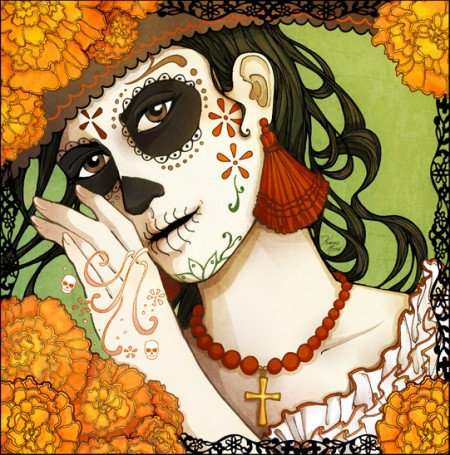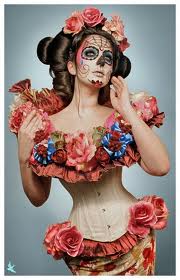Many – I would venture to say most – Americans have heard of the Mexican holiday of Dia de los Muertos, the Day of the Dead. But, many of us are still unsure of just what it means, and cultural misconceptions skew our impression of the holiday.
 Dia de los Muertos is celebrated in Latino cultures around the world on November 1st and 2nd. A National Holiday in Mexico, the day exists to honor loved ones who have died and to acknowledge death as a part of life. The day is celebrated with traditions like building altars to honor the dead, using the sugar skulls famously connected with the holiday as well as marigolds and the favorite foods and beverages of the deceased. Participants usually also visit the graves of loved ones, holding candle-lit memorials and placing these same mementos as gifts.
Dia de los Muertos is celebrated in Latino cultures around the world on November 1st and 2nd. A National Holiday in Mexico, the day exists to honor loved ones who have died and to acknowledge death as a part of life. The day is celebrated with traditions like building altars to honor the dead, using the sugar skulls famously connected with the holiday as well as marigolds and the favorite foods and beverages of the deceased. Participants usually also visit the graves of loved ones, holding candle-lit memorials and placing these same mementos as gifts.
A few common myths about Dia de los Muertos/Day of the Dead:
Myth:
Dia de Los Muertos is the Mexican version of Halloween.
Fact:

There are some clear similarities in the celebrations of Halloween and Day of the Dead: Costumes and treats and candy are common in both. And, most obvious, they are celebrated back to back on the calendar – Halloween on October 31st, and Day of the Dead on November 1st and 2nd. The important distinction, however, is the intent of each holiday.
Unlike Halloween, the Mexican holiday celebrates death and the lives of those who have passed. While Halloween presents are morbid and frightening images of death and promotes the idea of death and dying as something to be feared and repelled, Day of the Dead sees death as a natural part of life. The holiday is an opportunity to honor those who have died and to celebrate their lives, rather than to mourn loss and fear the end-of-life. Day of the Dead maintains a much stronger spiritual aspect than Halloween, which to many is focused on the costumes and sweets.
Myth:
The celebration of death is morbid and frightening.
Fact:
Dia de los Muertos is, in fact, a celebration of life. The holiday exists to honor the dead by celebrating and remembering the lives they lived. It also encourages the belief that death is a natural part of the cycle of life. Rather than fear death, Dia de los Muertos embraces it.
Myth:
Dia de los Muertos is a Mexican Catholic holiday.
Fact:
Although most widely-recognized in Mexico, Dia de los Muertos is celebrated in countries around the world. Its origins trace back to the native Aztec cultures of Mexico, who have honored the death of ancestors with the celebration for as long as two or three thousand years. The holiday was originally celebrated in the ninth month of the Aztec calendar, around the beginning of what is now August, for an entire month.
When Spanish missionaries came to Mexico, the celebration was moved to the 1st and 2nd of November to coincide with the Catholic holidays of All Saints Day and All Souls Day. With some similar intent of the holidays, and the spread of the Catholic religion throughout Mexico, Day of the Dead is now often celebrated in connection with All Saints Day and All Souls Day.
For more on Day of the Dead, check out these related posts:How to Make Your Own Sugar Skull
Halloween’s Deathly History
A Night for All Souls

 Unlocking the Meaning of Dia de los Muertos
Unlocking the Meaning of Dia de los Muertos


 “As Tears Go By” by Marianne Faithfull
“As Tears Go By” by Marianne Faithfull

 Funeral Favors Offer Visitors a Tangible Memento
Funeral Favors Offer Visitors a Tangible Memento















